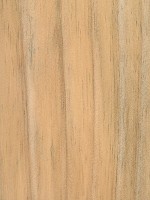 |
Common Name(s): Patula Pine Scientific Name: Pinus patula Distribution: Native to eastern Mexico; also grown on plantations in tropical regions Tree Size: 100-130 ft (30-40 m) tall, 2-3 ft (.6-1m) trunk diameter Average Dried Weight: 36 lbs/ft3 (575 kg/m3) Specific Gravity (Basic, 12% MC): .45, .58 Janka Hardness: 550 lbf (2,450 N) Modulus of Rupture: 11,500 lbf/in2 (79.3 MPa) Elastic Modulus: 1,463,000 lbf/in2 (10.09 GPa) Crushing Strength: 5,160 lbf/in2 (35.6 MPa) Shrinkage:Radial: 4.1%, Tangential: 7.9%, Volumetric: 12.6%, T/R Ratio: 1.9 |
Color/Appearance: Heartwood is light pinkish brown, sapwood is a paler yellowish white, though not usually distinct from the heartwood.
Grain/Texture: Straight grained with a medium, even texture.
Rot Resistance: The heartwood is rated as non-durable to perishable in regards to decay resistance.
Workability: Patula Pine works well with both hand and machine tools. Glues and finishes well.
Odor: Patula Pine has a faint, resinous odor while being worked.
Allergies/Toxicity: Working with pine has been reported to cause allergic skin reactions and/or asthma-like symptoms in some people. See the articles Wood Allergies and Toxicity and Wood Dust Safety for more information.
Pricing/Availability: Much like Radiata Pine, Patula Pine has a somewhat narrow natural distribution which is greatly expanded through plantation trees. Patula Pine is grown for basic construction purposes and should be available in tropical and sub-tropical regions for a modest price.
Sustainability: This wood species is not listed in the CITES Appendices, and is reported by the IUCN as being a species of least concern.
Common Uses: Paper (pulpwood), boxes/crates, and construction lumber.
Comments: Patula is latin for open or spreading, and the tree is sometimes called Spreading-Leaved Pine.
- Austrian Pine (Pinus nigra)
- Caribbean Pine (Pinus caribaea)
- Eastern White Pine (Pinus strobus)
- Jack Pine (Pinus banksiana)
- Jeffrey Pine (Pinus jeffreyi)
- Khasi Pine (Pinus kesiya)
- Limber Pine (Pinus flexilis)
- Loblolly Pine (Pinus taeda)
- Lodgepole Pine (Pinus contorta)
- Longleaf Pine (Pinus palustris)
- Maritime Pine (Pinus pinaster)
- Ocote Pine (Pinus oocarpa)
- Pinyon Pine (Pinus edulis)
- Pitch Pine (Pinus rigida)
- Pond Pine (Pinus serotina)
- Ponderosa Pine (Pinus ponderosa)
- Radiata Pine (Pinus radiata)
- Red Pine (Pinus resinosa)
- Sand Pine (Pinus clausa)
- Scots Pine (Pinus sylvestris)
- Shortleaf Pine (Pinus echinata)
- Slash Pine (Pinus elliottii)
- Spruce Pine (Pinus glabra)
- Sugar Pine (Pinus lambertiana)
- Sumatran Pine (Pinus merkusii)
- Table Mountain Pine (Pinus pungens)
- Western White Pine (Pinus monticola)
- Virginia Pine (Pinus virginiana)
Scans/Pictures: There are currently no pictures of this exact wood species, but a similar species within the Pinus genus is being substituted (P. radiata). If you’d like to contribute a wood sample of this specific species to be scanned, (even small pieces of veneer can be sent), please use the contact form.





